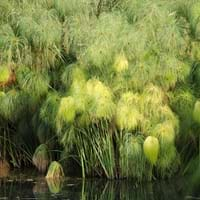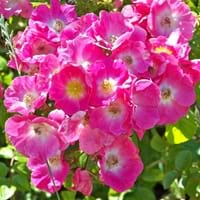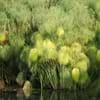Life Span
Perennial
Annual and Perennial
Type
Sedge or Rush
Perennial
Origin
Africa
Hybrid origin
Types
C. papyrus, C. papyrus 'Nanus
it is a type of rose
Number of Varieties
Not Available
Habitat
Lakes, Shores of rivers or lakes, sluggish streams and rivers, Swamps
Not Available
USDA Hardiness Zone
7-11
5-8
Sunset Zone
H1, H2, 16, 17, 23, 24
A1, A2, A3, H1, H2, 1a, 1b, 2a, 2b, 3a, 3b, 4, 5, 6, 7, 8, 9, 10, 11, 12, 13, 14, 15, 16, 17, 18, 19, 20, 21, 22, 23, 24
Habit
Clump-Forming
Vining/Climbing
Minimum Width
Not Available
Flower Color
Tan
White, Pink
Flower Color Modifier
Bicolor
Not Available
Fruit Color
Brown
Non Fruiting Plant
Leaf Color in Spring
Green, Light Green
Dark Green
Leaf Color in Summer
Green, Light Green
Dark Green
Leaf Color in Fall
Green, Light Green
Dark Green
Leaf Color in Winter
Green, Light Green
Light Green
Leaf Shape
Grass like
Oval
Plant Season
Spring, Summer, Fall, Winter
Summer
Sunlight
Full Sun, Partial Sun
Full Sun, Partial Sun
Type of Soil
Clay, Loam, Sand
Loam, Sand
The pH of Soil
Neutral
Acidic, Neutral
Soil Drainage
Poorly Drained
Well drained
Bloom Time
Indeterminate
Summer, Late Summer
Tolerances
Drought
Drought
Where to Plant?
Container, Ground, Pot
Container, Ground, Pot
How to Plant?
Stem Planting
Divison, Seedlings
Plant Maintenance
Medium
Medium
Watering Requirements
Average Water Needs, Keep ground moist, Requires a lot of watering
Water Deeply, Water in morning to avoid prompting diseases
In Summer
Lots of watering
Lots of watering
In Spring
Moderate
Moderate
In Winter
Average Water
Average Water
Soil pH
Neutral
Acidic, Neutral
Soil Type
Clay, Loam, Sand
Loam, Sand
Soil Drainage Capacity
Poorly Drained
Well drained
Sun Exposure
Full Sun, Partial Sun
Full Sun, Partial Sun
Pruning
Remove damaged leaves, Remove dead branches, Remove dead leaves
Prune after flowering, Remove damaged leaves, Remove dead branches
Fertilizers
All-Purpose Liquid Fertilizer
Fast release fertilizer, Fertilize in early spring, Fertilize three times a year
Pests and Diseases
fungus
Aphids, Black Spot, Caterpillars, Downy mildew, glasshouse red spider mite, Insects, Leaf Hoppers, Powdery mildew, rose leaf-rolling sawfly, Rust, Scale
Plant Tolerance
Drought
Drought
Flower Petal Number
Single
Single
Foliage Texture
Not Available
Medium
Foliage Sheen
Glossy
Glossy
Attracts
Flying insects, Hummingbirds
Not Available
Allergy
Not Available
Not Available
Aesthetic Uses
Showy Purposes
Showy Purposes, Used for decorating walls, fences, gates, hedges, etc.
Beauty Benefits
Not Available
Perfumes
Edible Uses
Insignificant
No
Environmental Uses
Air purification
Air purification
Medicinal Uses
Cancer, Heals minor burns, Wounds
No Medicinal Use
Part of Plant Used
Stem
Flowers, Whole plant
Other Uses
Constructing Boats, Used as fuel, Used in paper industry
Used as Ornamental plant
Used As Indoor Plant
Yes
Yes
Used As Outdoor Plant
Yes
Yes
Garden Design
Bog Garden, Container, Feature Plant, Houseplant, Mixed Border, Water Gardens
Cutflower, Feature Plant, Groundcover, Hedges, Mixed Border, Rock Garden / Wall, Topiary / Bonsai / Espalier, Vine
Botanical Name
CYPERUS 'Wild Spike'
ROSA 'American Pillar'
Common Name
Papyrus, Wild Spike Cyperus
Climbing Rose, Rambling Rose
In Hindi
पेपिरस संयंत्र
Climbing Rose
In German
ägyptischen Papyrus-Pflanze
Kletterrose
In French
Papyrus égyptien
escalade Rose
In Spanish
Papiro egipcio
Rose que sube
In Greek
αιγυπτιακό πάπυρο
αναρρίχηση Rose
In Portuguese
Papiro egípcio
Rosa de escalada
In Polish
Papiro egipcio
Climbing Rose
In Latin
CHARTA
Rosa scandere
Phylum
Magnoliophyta
Magnoliophyta
Class
Agaricomycetes
Magnoliopsida
Family
Cyperaceae
Rosaceae
Clade
Angiosperms, Commelinids, Monocots
Not Available
Tribe
Cariceae
Not Available
Subfamily
Cyperoideae
Not Available
Number of Species
Not Available
Not Available
Season and Care of Egyptian Papyrus and Climbing Rose
Season and care of Egyptian Papyrus and Climbing Rose is important to know. While considering everything about Egyptian Papyrus and Climbing Rose Care, growing season is an essential factor. Egyptian Papyrus season is Spring, Summer, Fall and Winter and Climbing Rose season is Spring, Summer, Fall and Winter. The type of soil for Egyptian Papyrus is Clay, Loam, Sand and for Climbing Rose is Loam, Sand while the PH of soil for Egyptian Papyrus is Neutral and for Climbing Rose is Acidic, Neutral.
Egyptian Papyrus and Climbing Rose Physical Information
Egyptian Papyrus and Climbing Rose physical information is very important for comparison. Egyptian Papyrus height is 60.00 cm and width 60.00 cm whereas Climbing Rose height is 300.00 cm and width Not Available. The color specification of Egyptian Papyrus and Climbing Rose are as follows:
Egyptian Papyrus flower color: Tan
Egyptian Papyrus leaf color: Green and Light Green
Climbing Rose flower color: White and Pink
- Climbing Rose leaf color: Dark Green
Care of Egyptian Papyrus and Climbing Rose
Care of Egyptian Papyrus and Climbing Rose include pruning, fertilizers, watering etc. Egyptian Papyrus pruning is done Remove damaged leaves, Remove dead branches and Remove dead leaves and Climbing Rose pruning is done Prune after flowering, Remove damaged leaves and Remove dead branches. In summer Egyptian Papyrus needs Lots of watering and in winter, it needs Average Water. Whereas, in summer Climbing Rose needs Lots of watering and in winter, it needs Average Water.





